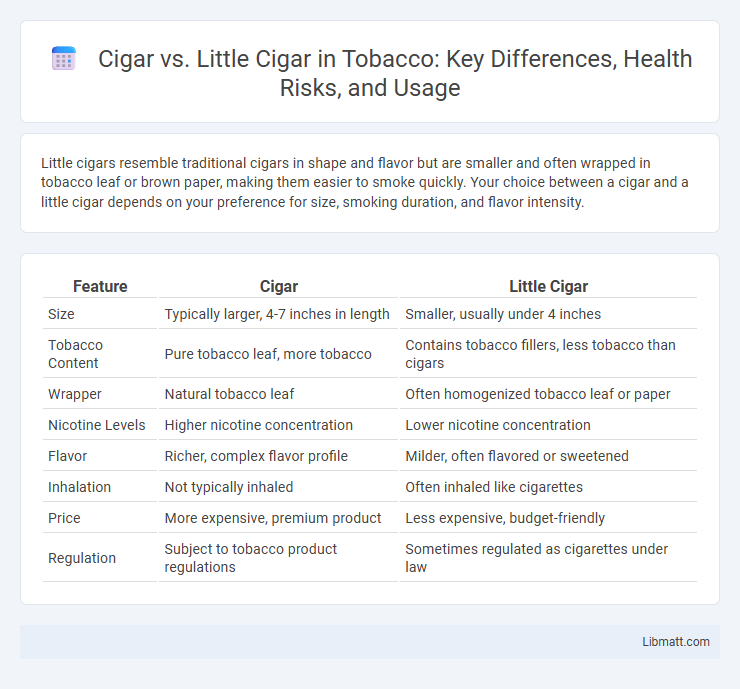Little cigars resemble traditional cigars in shape and flavor but are smaller and often wrapped in tobacco leaf or brown paper, making them easier to smoke quickly. Your choice between a cigar and a little cigar depends on your preference for size, smoking duration, and flavor intensity.
Table of Comparison
| Feature | Cigar | Little Cigar |
|---|---|---|
| Size | Typically larger, 4-7 inches in length | Smaller, usually under 4 inches |
| Tobacco Content | Pure tobacco leaf, more tobacco | Contains tobacco fillers, less tobacco than cigars |
| Wrapper | Natural tobacco leaf | Often homogenized tobacco leaf or paper |
| Nicotine Levels | Higher nicotine concentration | Lower nicotine concentration |
| Flavor | Richer, complex flavor profile | Milder, often flavored or sweetened |
| Inhalation | Not typically inhaled | Often inhaled like cigarettes |
| Price | More expensive, premium product | Less expensive, budget-friendly |
| Regulation | Subject to tobacco product regulations | Sometimes regulated as cigarettes under law |
Understanding Cigars and Little Cigars
Cigars and little cigars differ primarily in size, construction, and tobacco content, with cigars typically being larger and made from a single tobacco leaf, while little cigars resemble cigarettes in shape and often use reconstituted tobacco. Understanding these differences helps you choose the right product based on flavor intensity, smoking experience, and regulatory distinctions. Little cigars usually have filters and are subject to cigarette tax laws, whereas premium cigars often offer a richer, slow-burning smoke with complex flavors.
Key Differences in Size and Shape
Cigars are generally larger with a thicker diameter, offering a longer and more robust smoking experience, while little cigars are smaller, often similar in size and shape to cigarettes, making them more compact and convenient. The shape of cigars can vary from cylindrical to tapered, whereas little cigars usually maintain a consistent cylindrical form. Size and shape differences significantly influence burn time, flavor intensity, and portability between cigars and little cigars.
Tobacco Blend and Quality Comparison
Cigars typically use long-leaf tobacco with aged, high-quality fillers and wrappers, providing a richer, more complex flavor profile compared to little cigars. Little cigars often incorporate a blend similar to cigarettes, including short-leaf tobaccos and homogenized tobacco leaf wrappers, resulting in a milder taste. The difference in tobacco blend directly impacts the smoking experience, with premium cigars offering greater depth and complexity than the generally more affordable, blended tobacco used in little cigars.
Flavor Profiles: Cigar vs Little Cigar
Cigars typically offer a richer and more complex flavor profile, featuring earthy, spicy, and sometimes sweet notes derived from premium tobacco leaves aged for months or years. Little cigars, while similar in appearance, generally have a milder taste with less nuanced flavors due to shorter aging and the use of different tobacco blends that resemble cigarettes. Your choice between the two will depend on whether you prefer a bold, full-bodied experience or a lighter, more accessible smoke.
Smoking Experience and Duration
Cigars typically provide a longer smoking experience, often lasting 30 to 90 minutes due to their larger size and thicker construction, while little cigars offer a shorter duration of around 5 to 15 minutes because of their smaller size. The smoking experience of cigars is generally richer and more complex, with a variety of flavor profiles influenced by different tobacco blends, whereas little cigars tend to deliver a more straightforward taste similar to cigarettes. Your choice between the two depends on whether you prefer a leisurely, flavor-intensive session or a quicker, more convenient smoking option.
Packaging and Presentation Styles
Cigars typically come in elegant, sturdy boxes or humidors that preserve freshness and showcase premium craftsmanship, while little cigars are often packaged in small, foil-wrapped packs similar to cigarettes, prioritizing portability. The presentation of cigars emphasizes luxury with detailed labels and embossed logos, whereas little cigars focus on convenience with simpler designs and resealable packaging. Your choice between these options hinges on whether you value sophisticated presentation or compact, everyday usability.
Health Risks and Misconceptions
Little cigars and cigars both pose significant health risks, including increased chances of lung cancer, heart disease, and respiratory issues due to their tobacco content and combustion byproducts. Misconceptions often arise because little cigars are sometimes perceived as less harmful or less addictive than cigars or cigarettes, yet they deliver similar levels of nicotine and carcinogens. Users may underestimate the dangers, leading to higher risks of nicotine dependence, oral cancers, and chronic obstructive pulmonary disease (COPD).
Regulatory Differences and Taxation
Little cigars and cigars face distinct regulatory and taxation frameworks, with little cigars often classified similarly to cigarettes under federal law, resulting in higher taxes and stricter packaging regulations. Cigar products benefit from more lenient advertising restrictions and lower excise taxes, reflecting their traditional classification. Understanding these differences can help you navigate legal requirements and cost implications when purchasing or selling tobacco products.
Popular Brands of Cigars and Little Cigars
Popular cigar brands include Arturo Fuente, Padron, and Cohiba, renowned for their premium tobacco quality and rich flavors. In contrast, little cigar brands such as Swisher Sweets, Black & Mild, and Backwoods cater to a market seeking smaller, often flavored smoking options with a more affordable price point. Both categories appeal to distinct consumer preferences, with cigars favored for traditional smoking experiences and little cigars popular for convenience and flavor variety.
Choosing Between a Cigar and a Little Cigar
Choosing between a cigar and a little cigar depends on factors such as size, flavor intensity, and smoking experience. Cigars typically offer a longer, richer smoke with complex tobacco blends, while little cigars are smaller, often machine-made, and resemble cigarettes in flavor and draw. For those seeking a quick, convenient smoke with a milder taste, little cigars are preferred, whereas cigar aficionados usually opt for traditional cigars for their fuller flavor and craftsmanship.
Cigar vs Little cigar Infographic

 libmatt.com
libmatt.com